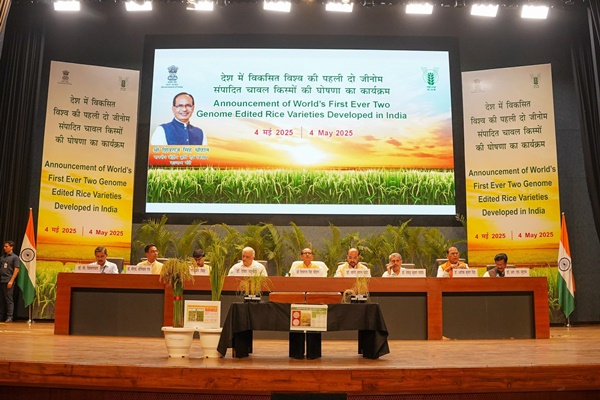In a groundbreaking development for Indian agriculture, the Indian Council of Agricultural Research (ICAR) has introduced the nation’s first genome-edited rice varieties: DRR Rice 100 (Kamla) and Pusa DST Rice 1. This major leap forward signals a transformative moment in sustainable farming, promising higher yields, improved climate resilience, and efficient water usage — critical factors as India faces the dual challenges of feeding a growing population and adapting to a changing climate.
ABOUT GENOME-EDITED RICE VARIETIES:
Genome editing is a cutting-edge technique that allows scientists to make precise, targeted changes to the DNA of plants, animals, or microorganisms. Unlike traditional genetic modification (GMO), which often involves inserting foreign genes, genome editing (particularly using CRISPR/Cas9 technology) tweaks the organism’s existing genes without adding anything new from outside species. This makes the process faster, safer, and often more publicly acceptable.
In the case of these new rice varieties, genome editing was used to fine-tune specific traits without altering the essential characteristics of the plant.
Unlike traditional genetic modification, which introduces foreign genes, genome editing can involve alterations that occur naturally, thus often bypassing stringent regulatory frameworks. In India, such genome-edited plants are classified under SDN-1 and SDN-2 categories, which do not require biosafety assessments, streamlining their development and potential commercialization .
THE GENOME EDITED HIGH YIELDING VARIETIES OF RICE:
1. DRR Rice 100 (Kamla)
Developed by the ICAR-Indian Institute of Rice Research (IIRR), DRR Rice 100 (Kamla) is engineered for higher yield potential and resilience. It shows improved performance under varied environmental stresses, particularly beneficial as erratic monsoon patterns become more frequent due to climate change.
2. Pusa DST Rice 1
Created by the ICAR-Indian Agricultural Research Institute (IARI), Pusa DST Rice 1 is tailored to tolerate drought stress. Through precise genome editing, researchers have enhanced the plant’s ability to thrive in water-scarce conditions, which is a huge advantage for regions increasingly suffering from groundwater depletion.
KEY FEATAURES OF NEW VARIETIES:
The newly developed rice varieties exhibit several promising traits:
- Increased Yield: Modifications have led to a significant rise in the number of grains per panicle, enhancing overall productivity.
- Drought Resistance: These varieties are engineered to withstand water scarcity, crucial for regions facing erratic rainfall patterns.
- Herbicide Tolerance: The incorporation of specific genetic changes allows these rice plants to tolerate certain herbicides, simplifying weed management .
These advancements are expected to contribute to higher farmer incomes and improved food security.
RESEARCH AND DEVELOPMENT:
Institutions like the Indian Institute of Rice Research (IIRR) have been at the forefront of this innovation. By using CRISPR/Cas9 technology, researchers have edited genes in popular rice varieties such as Samba Mahsuri to enhance yield and stress tolerance .
Additionally, the establishment of the M.S. Swaminathan Genome Editing Laboratory aims to further accelerate genome editing research, focusing on large-scale applications in rice improvement .
India’s progressive stance on genome editing is evident in its regulatory approach. The government has exempted SDN-1 and SDN-2 genome-edited plants from traditional biosafety assessments, recognizing their potential to enhance agricultural productivity without introducing foreign DNA . This policy shift is expected to expedite the development and deployment of such crops.
The release of DRR Rice 100 and Pusa DST Rice 1 is just the beginning. These innovations showcase the potential of modern biotechnology to address age-old agricultural problems. If scaled effectively, India could see a new wave of resilient crop varieties that support sustainable agriculture while improving farmers’ livelihoods.
India’s leadership in genome-edited rice sets a precedent for other nations, especially those with significant rice cultivation. By embracing advanced biotechnological tools, India not only addresses domestic agricultural challenges but also contributes to global food security efforts.



